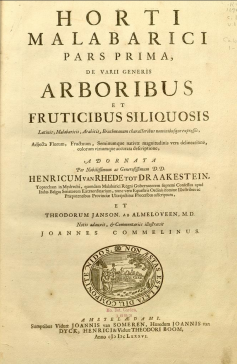In the 1650s, the Dutch East India Company (VOC), the biggest player in the global exchange economy centered on the Atlantic, developed a series of initiatives to better learn the truths of Asian nature. The VOC had an enviable information network, which underpinned their supply chains in the Indian Ocean region. Their employees—the merchants, ships’ captains, sailors and surgeons who found and shipped the natural objects from Asia that dazzled Europe—reported back on their experiences of the new worlds they encountered. They created fine-grained experiential descriptions of plants, animals, and minerals in order to identify them in unfamiliar milieus. For these men, knowledge was created not by freeing the mind from the world, but by closely engaging with it.
This project studies the Hortus Indicus Malabaricus (published 1678–1693), a twelve-volume survey of the floral riches of the Malayalam-speaking parts of southwest India (“Malabar”). Hendrik Adriaan van Reede tot Drakenstein (1636–1691), its principal creator, worked closely with a Discalced Carmelite, Matthew of St. Joseph, the botanist and medical doctor Paulus Hermann, the European artists who accompanied him, and, most importantly, three Tulu Brahmin physicians, Ranga, Apu, and Vinayaka Bhatta, and the Chogan (Ezhava) doctor Itti Achudan. The project will study the volumes of the Hortus, deconstructing and historicizing the knowledge it contains. The questions addressed to the material will be formulated to de-center familiar European categories of analysis, by identifying the Keralan, caste-based categories through which physician practice and materia medica appear in the Latin descriptions. Carefully selected plant descriptions will be translated from Latin into English, in consultation with scholars of seventeenth-century Dutch medicine, botany, and visual culture, as well as experts on the botany of southwest India, Ezhava medicine, and classical Ayurveda. The project’s goal is to produce a single-volume critical edition of the Hortus’s plant descriptions, accompanied by scholarly essays on different aspects of the work.

